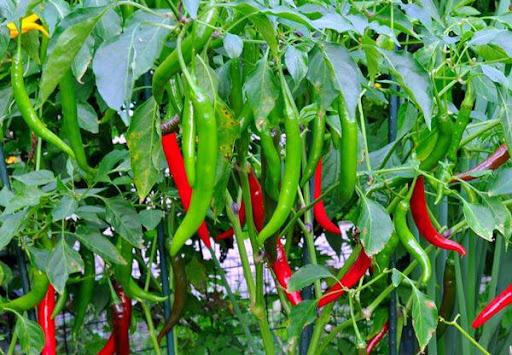There are many types of chili peppers: sweet peppers, spicy peppers… Sweet peppers are used as vegetables, spicy peppers are used as spices and medicine.
All branches, leaves, fruits and roots of the chili plant are used as medicine. The fruit is used fresh or dried. The leaves are mainly used fresh.
Characteristics of chili peppers
1. Long chili
Long, juicy, cylindrical pepper.
The scientific name of this pepper is Capsicum frutescens L. (C. annuum L.), belonging to the Solanaceae family.
Long-fruited pepper is a small shrub, 0.5-1m high, with many branches. The leaves are entire, opposite, and ovate-pointed. The flowers are in the leaf axils, usually solitary, rarely in pairs. The calyx is bell-shaped; the corolla is wheel-shaped or bell-shaped, divided into 6 lobes, white or pale yellow; there are 5 stamens, and the ovary has 2-3 cells. The fruit is berry, usually cylindrical, pointed at the tip, but can also have different shapes, sizes, and colors. The seeds are flat and kidney-shaped.
2. Chili pepper
Chili pepper has the scientific name Capsicum frutescens L. var. fasciculatum (Sturt.) Bail, also belonging to the Solanaceae family.
It is a shrub, but smaller than the long-fruited chili tree, with narrow leaves and smooth foliage. The fruit is thin, growing upright in clusters at the ends of the branches; bright red, very spicy.
3. Chili pepper
Chili pepper also has the scientific name Capsicum frutescens L. var. cerasiforme (Mill.), also belonging to the Solanaceae family. The fruit is as big as a cherry, 2 cm in diameter, and bright red.

Chili peppers are used as spices and medicine to relieve pain and disinfect.
In recent years, many non-spicy chili peppers have been used, commonly known as sweet peppers, tomato peppers, Dalat peppers… The scientific name is Capsicum frutescens L. var. grossum (L.) Bail., also a plant in the Solanaceae family.
This chili pepper has large, round or bag-shaped, wrinkled fruits, green when young, yellow or orange-red when ripe, thick skin, very fragrant, but not spicy.
Effects of chili pepper
Chili fruit: Spicy, hot, enters the Heart and Spleen meridians. Has the effect of warming the middle, dispelling cold, strengthening the spleen, and digesting food. Used to treat diarrhea, stagnation, malaria, clear the meridians, relieve pain, and disinfect.
Folk experience when having a migraine, take chili oil or a fresh chili pepper, break it in half, and apply it to the nose on the side of the head that is painful, the pain will decrease very quickly. Then to relieve the spiciness, apply hair to the spicy area.
Chili leaves: Bitter taste, cool, has the effect of clearing heat, detoxifying, and diuresis.
Chili roots: Similar in taste and effect to the fruit, have the effect of activating blood circulation, dispelling swelling; often used to treat tired limbs, swollen and painful testicles, and functional uterine bleeding.
Chili branches: Spicy hot, has the effect of eliminating cold and dampness, dispelling stagnation; used to treat rheumatism (bone and joint pain caused by cold), and winter rash (soft tissue damage caused by cold).
Note: People with heat in their body, “yin deficiency and excess fire” (yin deficiency, internal heat), cough, eye disease, or stomach pain should not use.
Remedies to support treatment from chili plants
1. Treatment of back pain, rheumatism, nerve pain: Crush chili fruit, soak in alcohol with a ratio of 1/2 (one part fresh chili, two parts alcohol) for massage.
2. Treatment of stroke, teeth clenched: Fresh chili leaves (chili pepper) 30-50g, crush, add water and a little salt, filter to get the juice, pour into the mouth and apply the pulp to the teeth of the patient to wake up.
3. Treatment of malaria: Fresh chili leaves 30g, crush, mix with boiled water to cool, squeeze the juice and drink 2 hours before the fever. Once a day, use for 5-7 consecutive days.
4. Treatment of edema: Fresh chili leaves 30 – 40g, stir-fry until golden, boil and drink during the day.
5. Cure snake bites, insect bites: 15 fresh chili peppers, 3 papaya leaves, 80g chili pepper roots, crush all, add water, filter the water to drink, use the residue to apply on the bite.
If it is a centipede or insect bite, use a smaller amount. You can use a sufficient amount of fresh chili pepper leaves, crush them, and apply on the bite. After 15-30 minutes, if the pain persists, do it again.
6. Cure eczema: 30g fresh chili pepper leaves, 20g tamarind, crush both and apply, use for 5-10 days to cure.
7. Cure boils, soft tissue injuries: 10-20g chili pepper leaves, custard apple leaves, dandelion leaves, purple perilla leaves, and apple leaves, crush with a little salt, apply on the injured area.
8. Cure chronic abdominal pain: 10g chili pepper roots, 10g lemon roots, 10g Sichuan pepper roots. The yellow star fruit is drunk during the day.
9. Treating joint pain due to cold or injury from falling: 12g chili, soaked in 500ml of alcohol; after 20-30 days, it can be used. Drink 5-10ml each time, 2 times a day.
10. Treating hair loss: 12g chili, soaked in 500ml of alcohol. After 10-15 days, it can be used. Use cotton to soak in chili wine, apply to the hair loss area 2-3 times a day to stimulate hair growth.
11. Treating skin inflammation with blisters, ulcers: Dry the chili fruit, grind it into a fine powder, sprinkle on the wound, once a day.
12. Treating skin damage, redness, pain, or itching, numbness due to cold (winter): Use chili to boil the water to wash, or cook in vegetable oil (to make “chili oil”), apply to the damaged area.
13. Treatment of chilblains in the elderly due to cold weather: 60g chili branches, 20g tangerine peel, 30g garlic. Boil in water, use cotton to soak the medicine and apply to the chilblains, 2-3 times a day.





